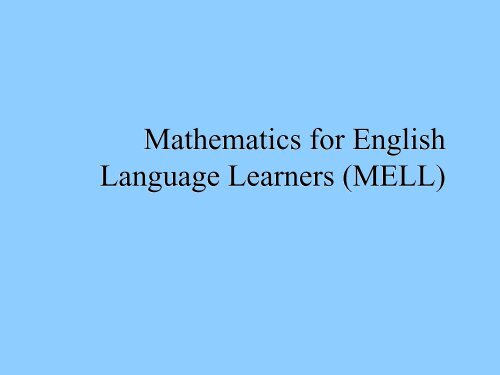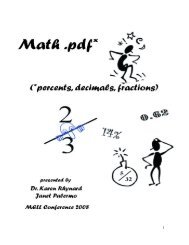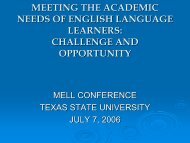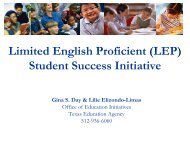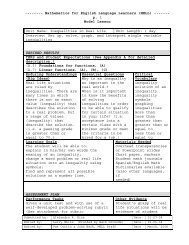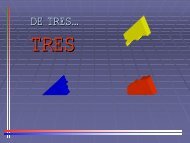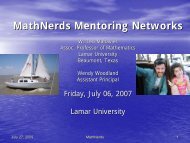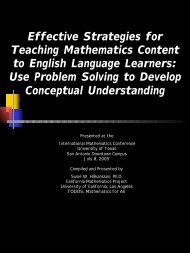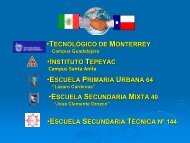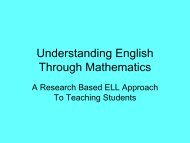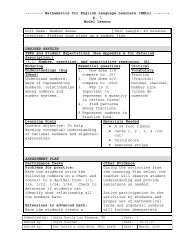Title Slide - Mathematics for English Language Learners Project
Title Slide - Mathematics for English Language Learners Project
Title Slide - Mathematics for English Language Learners Project
You also want an ePaper? Increase the reach of your titles
YUMPU automatically turns print PDFs into web optimized ePapers that Google loves.
<strong>Mathematics</strong> <strong>for</strong> <strong>English</strong><br />
<strong>Language</strong> <strong>Learners</strong> (MELL)
MELL Partnership<br />
• MELL is a partnership between Texas State<br />
University System, its five member<br />
universities, and the Texas Education<br />
Agency.<br />
• Texas State University System Universities<br />
• Angelo State University<br />
• Lamar University<br />
• Sam Houston State University<br />
• Sul Ross State University<br />
• Texas State University–San Marcos<br />
MELL: a joint initiative between TEA and the<br />
Texas State University System<br />
2
A Place to Begin<br />
• Underlying Assumptions<br />
• Teachers have very “full plates” and many<br />
demands<br />
• TAKS standards are substantive and<br />
challenging<br />
• ELL students face additional challenges that are<br />
currently reflected in TAKS results<br />
MELL: a joint initiative between TEA and the<br />
Texas State University System<br />
3
A Place to Begin, Continued<br />
• Underlying Assumptions<br />
• Texas educators are working hard to improve<br />
the per<strong>for</strong>mance of all students, including those<br />
who are <strong>English</strong> <strong>Language</strong> <strong>Learners</strong><br />
• Educators are interested in acquiring additional<br />
knowledge and skills to better address the needs<br />
of ELL students<br />
MELL: a joint initiative between TEA and the<br />
Texas State University System<br />
4
• MELL’s goal is to help educators better<br />
meet the instructional needs of<br />
<strong>English</strong> <strong>Language</strong> <strong>Learners</strong><br />
MELL: a joint initiative between TEA and the<br />
Texas State University System<br />
5
2005 <strong>Mathematics</strong> TAKS Scores<br />
by Grade Level and Group<br />
90%<br />
80%<br />
70%<br />
60%<br />
50%<br />
40%<br />
30%<br />
20%<br />
10%<br />
0%<br />
State Afr. Am. Hisp White LEP<br />
MELL: a joint initiative between TEA and the<br />
Texas State University System<br />
6 Math(Eng)<br />
7 Math<br />
8 Math<br />
9 Math<br />
10 Math<br />
11 Math<br />
6
Percentages of Students Meeting 2005 Standards on TAKS (Sum of All Grades<br />
Tested)<br />
1<br />
0.9<br />
0.8<br />
0.7<br />
0.6<br />
0.5<br />
0.4<br />
RDG/LA<br />
MATH<br />
WRITING<br />
SCIENCE<br />
SOC STUDY<br />
0.3<br />
0.2<br />
0.1<br />
0<br />
STATE AFR AM HISP WHITE LEP<br />
Disaggregated Groups<br />
MELL: a joint initiative between TEA and the<br />
Texas State University System<br />
7
Achievement in math and science lag<br />
behind other academic areas.<br />
• To address this need, TEA has launched a<br />
comprehensive math professional<br />
development initiative.<br />
• MELL is one component of this initiative.<br />
MELL: a joint initiative between TEA and the<br />
Texas State University System<br />
8
<strong>English</strong> <strong>Language</strong> <strong>Learners</strong><br />
(ELLs)<br />
• ELLs include all students who have a native<br />
language other than <strong>English</strong>.<br />
• In Texas, the vast majority of ELLs are<br />
Hispanic students whose native language is<br />
Spanish.<br />
MELL: a joint initiative between TEA and the<br />
Texas State University System<br />
9
70<br />
60<br />
50<br />
Proportion of Net Population Change Attributable to<br />
Each Race/Ethnicity Group in Texas <strong>for</strong> 1980-1990 and<br />
1990-2000<br />
60.27<br />
49.11<br />
40<br />
34.14<br />
30<br />
20<br />
20.26<br />
10<br />
10.29<br />
6.46<br />
11.52<br />
7.95<br />
0<br />
1980-1990 1990-2000<br />
Anglo Black Hispanic Other<br />
MELL: a joint initiative between TEA and the<br />
Texas State University System<br />
Dr. Steven Murdock, State<br />
Demographer of Texas,<br />
http://txsdc.utsa.edu/<br />
10
ELL Trends<br />
• The ELL student population is currently a<br />
significant percentage of Texas students.<br />
• 15.3% in 2003-2004 [IDRA Newsletter -<br />
February 2005]<br />
• The ELL student population is expected to<br />
continue to increase in the coming years.<br />
MELL: a joint initiative between TEA and the<br />
Texas State University System<br />
11
Percent of Texas Population by Age Group<br />
and Ethnicity, 2040*<br />
70.0<br />
60.0<br />
50.0<br />
69.9<br />
67.8<br />
66.5 65.5 66.0 66.8 66.4<br />
64.3<br />
62.6<br />
60.6<br />
56.7<br />
55.2<br />
52.3<br />
39.8<br />
37.1<br />
30.0<br />
20.0<br />
17.7<br />
80.0 Percent Anglo Hispanic Dr. Steven Murdock, State<br />
40.0<br />
19.3 19.9 20.3 19.8 19.3 19.4<br />
20.5 20.6<br />
21.9<br />
25.3<br />
26.5 27.2<br />
10.0<br />
0.0<br />
< 5 years<br />
5 to 9 years<br />
10 to 14 years<br />
15 to 19 years<br />
20 to 24 years<br />
25 to 29 years<br />
30 to 34 years<br />
35 to 39 years<br />
40 to 44 years<br />
45 to 49 years<br />
50 to 54 years<br />
55 to 59 years<br />
60 to 64 years<br />
65 + years<br />
* <strong>Project</strong>ions are shown <strong>for</strong> the 1.0 scenario<br />
Demographer of Texas,<br />
http://txsdc.utsa.edu/<br />
MELL: a joint initiative between TEA and the<br />
Texas State University System<br />
12
<strong>Project</strong>ed Percent of Net Change Attributable to Each<br />
Race/Ethnicity Group <strong>for</strong> 2000-2040*<br />
Black<br />
5.6%<br />
Hispanic<br />
77.6%<br />
Anglo<br />
4.2%<br />
Other<br />
12.6%<br />
*Using U.S. Census count <strong>for</strong> 2000 and Texas State Data Center 1.0 population projection scenario <strong>for</strong> 2040.<br />
Dr. Steven Murdock, State<br />
Demographer of Texas,<br />
http://txsdc.utsa.edu/<br />
MELL: a joint initiative between TEA and the<br />
Texas State University System<br />
13
Dr. Steven Murdock, State<br />
Demographer of Texas,<br />
http://txsdc.utsa.edu/<br />
MELL: a joint initiative between TEA and the<br />
Texas State University System<br />
14
Pressing Need<br />
• There is a pressing educational, economic<br />
and societal need to increase math<br />
achievement of ELL students<br />
MELL: a joint initiative between TEA and the<br />
Texas State University System<br />
15
If current population trends continue and<br />
states do not improve the education of all<br />
racial/ethnic groups, the skills of the<br />
work<strong>for</strong>ce and the incomes of U.S.<br />
residents are projected to decline over the<br />
next two decades.<br />
The National Center <strong>for</strong> Public Policy and Higher<br />
Education, November 2005 Policy Alert
What Research Suggests<br />
About Math<br />
and <strong>English</strong> <strong>Language</strong> <strong>Learners</strong><br />
MELL: a joint initiative between TEA and the<br />
Texas State University System<br />
17
Teaching Strategies <strong>for</strong> LEP<br />
Students<br />
• Mather, J., & Chiodo, J. (1994). A mathematical<br />
problem: How do we teach mathematics to LEP<br />
elementary students?. The Journal of Educational<br />
Issues of <strong>Language</strong> Minority Students, 13, 1-12.<br />
• Stress understanding rather than rote computational<br />
procedures.<br />
• Provide profound exposure to manipulative, concrete,<br />
sensory, and hands-on activities, not to replace<br />
discussion, but to support it.<br />
• Use cooperative learning (small group activities) and<br />
minimize individual seatwork.<br />
• Provide opportunities <strong>for</strong> peer tutoring—preferably by<br />
another LEP or bilingual student who understands the<br />
concepts.<br />
MELL: a joint initiative between TEA and the<br />
Texas State University System<br />
18
Teaching Strategies <strong>for</strong> LEP<br />
Students, Continued<br />
• Mather, J., & Chiodo, J. (1994). A mathematical problem:<br />
How do we teach mathematics to LEP elementary<br />
students?. The Journal of Educational Issues of <strong>Language</strong><br />
Minority Students, 13, 1-12.<br />
• Include guided practice with close monitoring of students.<br />
• Use rein<strong>for</strong>cement, reward, and total motivational<br />
systems.<br />
• Emphasize multicultural referents and relevancy in<br />
lessons.<br />
• Use second language texts, materials, and resources as<br />
much as possible.<br />
MELL: a joint initiative between TEA and the<br />
Texas State University System<br />
19
Teaching Strategies <strong>for</strong> LEP<br />
Students, Continued<br />
• Mather, J., & Chiodo, J. (1994). A mathematical problem: How do<br />
we teach mathematics to LEP elementary students?. The Journal<br />
of Educational Issues of <strong>Language</strong> Minority Students, 13, 1-12.<br />
• Use limited, simplified instruction (using caution to retain<br />
the essence of the original content and problems); limited<br />
use of pronouns and adjectives; instruction with pauses<br />
and repetition; concerted ef<strong>for</strong>ts to be aware of and to<br />
explain any culturally-based terms.<br />
• Use basic mathematics vocabulary in the second<br />
language <strong>for</strong> individualized instruction whenever<br />
possible. Note that vocabulary should not be used to<br />
focus on key words but should be used in context to<br />
develop understanding.<br />
• Model expected student behavior..<br />
MELL: a joint initiative between TEA and the<br />
Texas State University System<br />
20
Teaching Strategies <strong>for</strong> LEP<br />
Students, Continued<br />
• Mather, J., & Chiodo, J. (1994). A mathematical problem:<br />
How do we teach mathematics to LEP elementary<br />
students?. The Journal of Educational Issues of <strong>Language</strong><br />
Minority Students, 13, 1-12.<br />
• Be aware of how other countries and cultures<br />
teach basic mathematical concepts.<br />
• Use programs that are designed to increase<br />
hands-on activities and relevancy and minimize<br />
abstraction.<br />
• Use such methods as Direct Instruction (e.g.,<br />
Active <strong>Mathematics</strong> Teaching, or Cognitively<br />
Guided Instruction<br />
MELL: a joint initiative between TEA and the<br />
Texas State University System<br />
21
New Insights<br />
• Recent research is showing that academic<br />
achievement among ELLS is greatest when<br />
students receive dual language instruction.<br />
• Thomas, W., & Collier, V. (2003). A national<br />
study of school effectiveness <strong>for</strong> language<br />
minority students’ long-term academic<br />
achievement (CREDE Research Brief # 10),<br />
Center <strong>for</strong> Research on Education, Diversity<br />
and Excellence.<br />
MELL: a joint initiative between TEA and the<br />
Texas State University System<br />
22
How is dual language different<br />
than bilingual?<br />
• Dual <strong>Language</strong><br />
• Instruction alternates<br />
between <strong>English</strong> only<br />
classes and native<br />
language only classes.<br />
• Bilingual Education<br />
• A combination of two<br />
languages used<br />
throughout the day<br />
MELL: a joint initiative between TEA and the<br />
Texas State University System<br />
23
<strong>Language</strong> Acquisition<br />
• A complex process influenced by many variables<br />
• Just as first language acquisition varies<br />
substantially among children, so will second<br />
language acquisition<br />
• Consider your own experiences in a <strong>for</strong>eign<br />
language class (some students have a natural<br />
ability while others struggle)<br />
• <strong>Mathematics</strong> involves a specialized language and<br />
vocabulary<br />
MELL: a joint initiative between TEA and the<br />
Texas State University System<br />
24
Today in Texas<br />
• Given current fiscal and human resources,<br />
statewide dual language instruction is presently<br />
not a viable option in Texas secondary schools,<br />
especially in mathematics.<br />
• Currently our best available option is to provide<br />
teachers with professional development and<br />
instructional resources targeted at enhanced<br />
instruction <strong>for</strong> ELL students.<br />
MELL: a joint initiative between TEA and the<br />
Texas State University System<br />
25
<strong>Mathematics</strong> and ELLS:<br />
Different Populations<br />
LANGUAGE PROFICIENCY<br />
MATH PROFICIENCY<br />
LIMITED <strong>English</strong><br />
Proficiency BUT<br />
MODERATE Math<br />
Proficiency<br />
LIMITED <strong>English</strong><br />
Proficiency &<br />
LIMITED Math<br />
Proficiency<br />
MODERATE <strong>English</strong><br />
Proficiency &<br />
MODERATE Math<br />
Proficiency<br />
MODERATE <strong>English</strong><br />
Proficiency but<br />
LIMITED Math<br />
Proficiency<br />
MELL: a joint initiative between TEA and the<br />
Texas State University System<br />
26
Classrooms as Greenhouses<br />
MELL has posed this question:<br />
“What conditions provide optimal growth <strong>for</strong><br />
ELL students in mathematics?”<br />
MELL: a joint initiative between TEA and the<br />
Texas State University System<br />
27
MELL doesn’t have THE answer<br />
• But we do have a current consensus based<br />
upon:<br />
• review of the research<br />
• analysis of professional development programs<br />
• teacher input, and<br />
• prolonged professional dialogue.<br />
MELL: a joint initiative between TEA and the<br />
Texas State University System<br />
28
MELL Classroom Practices<br />
Framework<br />
• Consists of six components which include<br />
enabling practices and indicators.<br />
• Learning Atmosphere and Physical Environment<br />
• Instructional Practices<br />
• <strong>Mathematics</strong> Content and Curriculum<br />
• <strong>Language</strong> Practices<br />
• Family and Community Involvement<br />
• Assessment of Student Learning<br />
MELL: a joint initiative between TEA and the<br />
Texas State University System<br />
29
MELL Classroom Practices<br />
Framework<br />
• Consists of six components which include<br />
enabling practices and indicators.<br />
• Learning Atmosphere and Physical Environment<br />
• Instructional Practices<br />
• <strong>Mathematics</strong> Content and Curriculum<br />
• <strong>Language</strong> Practices<br />
• Family and Community Involvement<br />
• Assessment of Student Learning<br />
MELL: a joint initiative between TEA and the<br />
Texas State University System<br />
30
MELL Classroom Practices<br />
Framework<br />
• Consists of six components which include<br />
enabling practices and indicators.<br />
• Learning Atmosphere and Physical Environment<br />
• Instructional Practices<br />
• <strong>Mathematics</strong> Content and Curriculum<br />
• <strong>Language</strong> Practices<br />
• Family and Community Involvement<br />
• Assessment of Student Learning<br />
MELL: a joint initiative between TEA and the<br />
Texas State University System<br />
31
MELL Classroom Practices<br />
Framework<br />
• Consists of six components which include<br />
enabling practices and indicators.<br />
• Learning Atmosphere and Physical Environment<br />
• Instructional Practices<br />
• <strong>Mathematics</strong> Content and Curriculum<br />
• <strong>Language</strong> Practices<br />
• Family and Community Involvement<br />
• Assessment of Student Learning<br />
MELL: a joint initiative between TEA and the<br />
Texas State University System<br />
32
MELL Classroom Practices<br />
Framework<br />
• Consists of six components which include<br />
enabling practices and indicators.<br />
• Learning Atmosphere and Physical Environment<br />
• Instructional Practices<br />
• <strong>Mathematics</strong> Content and Curriculum<br />
• <strong>Language</strong> Practices<br />
• Family and Community Involvement<br />
• Assessment of Student Learning<br />
MELL: a joint initiative between TEA and the<br />
Texas State University System<br />
33
MELL Classroom Practices<br />
Framework<br />
• Consists of six components which include<br />
enabling practices and indicators.<br />
• Learning Atmosphere and Physical Environment<br />
• Instructional Practices<br />
• <strong>Mathematics</strong> Content and Curriculum<br />
• <strong>Language</strong> Practices<br />
• Family and Community Involvement<br />
• Assessment of Student Learning<br />
MELL: a joint initiative between TEA and the<br />
Texas State University System<br />
34
Some Culminating Thoughts<br />
• The good news is that the instructional practices<br />
that promote ELL success also work well <strong>for</strong> other<br />
students<br />
• However, what is optimal <strong>for</strong> other students may,<br />
in fact, be necessary <strong>for</strong> ELLs as it appears that<br />
the success of ELL students (even more so than<br />
other students) is highly dependent upon a<br />
conducive learning environment<br />
MELL: a joint initiative between TEA and the<br />
Texas State University System<br />
35
MELL Products<br />
MELL: a joint initiative between TEA and the<br />
Texas State University System<br />
36
MELL Products<br />
• ELL Research Synthesis<br />
• Reviews the scientifically-based research literature<br />
regarding <strong>English</strong> <strong>Language</strong> <strong>Learners</strong> (ELL) and the<br />
teaching of mathematics <strong>for</strong> secondary students<br />
(particularly 11 th grade students).<br />
• A Summary of <strong>Mathematics</strong> Professional<br />
Development Models Used in the State of Texas<br />
• Identifies and summarizes twelve models of<br />
professional development in mathematics that are used<br />
in Texas. Summaries include an overview and an<br />
analysis and the <strong>for</strong>mat is consistent across models to<br />
facilitate comparisons.<br />
MELL: a joint initiative between TEA and the<br />
Texas State University System<br />
37
MELL Products<br />
• An Analysis of Existing PD Models<br />
• Analysis of each of the 12 identified PD models by<br />
identifying components of each that link to the six<br />
categories of the Classroom Practices Framework: 1)<br />
Learning Atmosphere & Physical Environment; 2)<br />
Instructional Practices; 3) <strong>Mathematics</strong> content &<br />
curriculum; 4) <strong>Language</strong> Practices; 5) Family &<br />
Community Involvement; and 6) Assessment of<br />
Student Learning.<br />
MELL: a joint initiative between TEA and the<br />
Texas State University System<br />
38
• Teachers Guide<br />
MELL Products<br />
• A guide designed <strong>for</strong> teachers to make<br />
mathematics more meaningful and<br />
understandable <strong>for</strong> the <strong>English</strong> <strong>Language</strong><br />
Learner (ELL). The initial focus of this guide<br />
is <strong>for</strong> grades7-11 and includes general teaching<br />
strategies that help the ELL when learning<br />
mathematics content.<br />
MELL: a joint initiative between TEA and the<br />
Texas State University System<br />
39
MELL Products<br />
• MELL Quick Start Module<br />
• A professional development tool designed to explore<br />
the issues surrounding the teaching of mathematics to<br />
<strong>English</strong> <strong>Language</strong> <strong>Learners</strong> and strategies to enhance<br />
learning. The module parallels the MELL Classroom<br />
Practices Framework and consists of various<br />
professional readings, activities, and resources. [The<br />
module is offered <strong>for</strong> graduate credit through Sul Ross State University and a noncredit<br />
version is available through the MELL website (www.tsusmell.org)].<br />
MELL: a joint initiative between TEA and the<br />
Texas State University System<br />
40
2005-06 MELL Scope of Work<br />
• Expand MELL products to encompass<br />
middle school and elementary instruction<br />
• Critical Campus Partnerships<br />
• Statewide Math Professional Development<br />
Collaborative<br />
MELL: a joint initiative between TEA and the<br />
Texas State University System<br />
41
Web Addresses<br />
• TSUS MELL Initiative<br />
www.tsusmell.org<br />
• TSUS Education Policy Implementation<br />
Center<br />
www.education.txstate.edu/epic<br />
MELL: a joint initiative between TEA and the<br />
Texas State University System<br />
42
Q & A Time<br />
MELL: a joint initiative between TEA and the<br />
Texas State University System<br />
43
For Additional In<strong>for</strong>mation<br />
• MELL Contact In<strong>for</strong>mation:<br />
• Dr. Leslie Huling, Director<br />
• Education Policy In<strong>for</strong>mation Center<br />
• La03@txstate.edu<br />
• (512) 716-4532<br />
MELL: a joint initiative between TEA and the<br />
Texas State University System<br />
44


